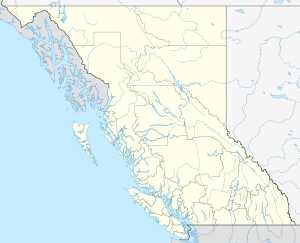Alex Fraser Bridge
Coordinates: 49 ° 9 '36 " N , 122 ° 56' 34" W.
| Alex Fraser Bridge | ||
|---|---|---|
| use |
|
|
| Crossing of | Fraser River | |
| place | Metro Vancouver | |
| construction | Cable-stayed bridge | |
| Longest span | 465 m | |
| Clear height | 55 m | |
| completion | 1986 | |
| planner | Buckland & Taylor et al. a. | |
| location | ||
|
|
||
The Alex Fraser Bridge (also Annacis Bridge called) is a road bridge in Greater Vancouver in British Columbia , Canada . It is located on Highway 91 , which crosses Annacis Island and the southern arm of the Fraser River coming from Richmond and connects to the Delta District .
It is named after Alex Fraser (1916–1989), a former Canadian Minister of Transportation.
Technical design
The bridge has two directional lanes, each with three lanes and a walkway on both sides. It is 2525 m long including the access ramps and crosses the river with a clearance height of 55 m.
The cable-stayed bridge with two H-shaped pylons and a fan-shaped arrangement of the stay cables has a main opening with a span of 465 m and two secondary openings, each with a span of 183 m.
The legs of the 158 m high reinforced concrete pylons are initially slightly curved inwards above the roadway to allow vertical cable levels above the edge of the roadway. They are stiffened by cross struts below the bridge deck and below the vertical peaks, in which the anchor boxes for the 192 stay cables are located. The bridge deck consists of a grid made of longitudinal and transverse girders on which precast concrete slabs are attached. It was cantilevered from the pylons evenly in both directions. In order to avoid vibrations of the cantilevered decks, they were stabilized with bracing at the pylon feet. As a floating deck, the bridge deck only hangs on the ropes; it does not rest on the cross members of the pylons.
For the Alex Fraser Bridge, planned by Buckland & Taylor, now COWI North America, together with Klohn Crippen Berger and completed in 1986 , the conception of a roadway girder made of a steel grid was first developed by Jörg Schlaich for the Second Hooghly Bridge (Vidyasagar Setu) in Calcutta realized with a concrete slab. The Second Hooghly Bridge was planned in the early 1970s, but was not completed until 1992.
The Alex Fraser Bridge had the longest span of all cable-stayed bridges in the world until it was replaced in 1991 by the Skarnsund Bridge in Norway.
Individual evidence
- ↑ Alex Fraser Bridge ( Memento of the original from March 4, 2016 in the Internet Archive ) Info: The archive link was inserted automatically and has not yet been checked. Please check the original and archive link according to the instructions and then remove this notice. Photo and brief description on the University of Delaware, College of Engineering website
- ↑ Alex Fraser Bridge on the PCL Construction Leaders website
- ↑ Photo of the bridge under construction ( Memento of the original from April 30, 2015 in the Internet Archive ) Info: The archive link was inserted automatically and has not yet been checked. Please check the original and archive link according to the instructions and then remove this notice.
- ↑ Alex Fraser Bridge on the Buckland & Taylor website, now COWI North America
- ↑ Alex Fraser Bridge on the website of Klohn Crippen Berger
- ↑ Jörg Schlaich: Well riveted is better than badly welded. Social bridge building - the Second Hooghly Bridge in Calcutta , in: Deutsche BauZeitschrift (DBZ), 8 | 2010, p. 20f.

